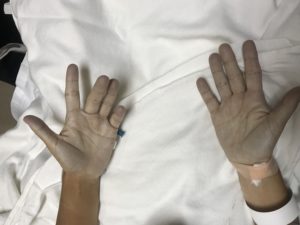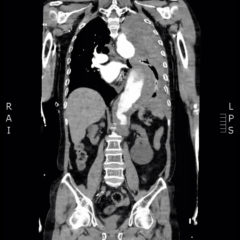Warm & Blue: A Case of Methemoglobinemia
History of present illness:
A 44-year-old female presented via ambulance for a syncopal episode while driving. Per paramedic report, she was found unresponsive with blue skin discoloration. On arrival to the emergency department, she was awake but confused and with delayed reciprocity in speech, but otherwise had no complaints. Upon further questioning, patient stated she was driving to a meeting when she started to feel as though she was going to “pass out.” She pulled over in a parking lot and the next thing she remembered was waking up in the ambulance. She denied ever experiencing anything like this before and has no history of syncope or seizures.
Significant findings:
The patient hadperioral cyanosis, blue coloration around her mouth, but the rest of the skin on her face appeared normal. She also had acrocyanosis to bilateral hands that can be seen in the image. The patient has a tan complexion up to the level of her wrists, but the palms of her hands are pale and cyanotic.
The pulse oximeter read 85% despite supplemental oxygen via a non-breather mask. The blood obtained for a venous blood gas was a chocolate brown color. The results of the venous blood gas was pH 7.417, pCO2 26.8 mmHg, pO2 14 mmHg, HCO3 17.3 mmHg, sO2 19%, base excess: -6. The methemoglobin level was obtained and returned elevated at 52%.
Discussion:
Despite the patient’s central cyanosis and oxygen saturation, she did not appear to be in any respiratory distress. Upon further questioning, the patient stated that she had a toothache for the past week and she had been using Anbesol and Orajel. She had used an entire 9 gram tube of Anbesol and recently finished a 7 gram tube of Orajel just prior to the incident.
Methemoglobinemia is a cause of central cyanosis that can be hereditary or acquired. Hereditary causes are rare and include deficiency of methemoglobin reductase or the presence of hemoglobin M. Acquired causes are due to oxidative stress, most commonly from local anesthetic agents, such as benzocaine.1 Methemoglobinemia secondary to a topical and/or over-the-counter benzocaine is a rare occurrence. The reported maximum dose before inducing methemoglobinemia is 15 mg/kg.2 Patients are usually asymptomatic until the levels reach 20%-30%. Once levels reach greater than 45% patients can present with bradycardia, dyspnea, and hypoxia.
The treatment is methylene blue, 1-2 mg/kg intravenously over 5 minutes. If there is no improvement within one hour, this dose may be repeated. Methylene blue is indicated for patients with symptomatic hypoxia or methemoglobin levels greater than 30%.3 If patients are asymptomatic, methylene blue is indicated for levels > 30%. If patients are symptomatic or have comorbidities such as heart disease, lung disease, carbon monoxide poisoning, or anemia, they should be treated when levels are 10%-30%. In most cases if levels are less than 10%, treatment is not indicated.1 Methemoglobinemia is treatable, and long-term sequelae can be eliminated when it is recognized and treated early.
Topics:
Methemoglobinemia, methylene blue, central cyanosis, benzocaine.
References:
- Wright RO, Lewander WJ, Woolf AD. Methemoglobinemia: etiology, pharmacology, and clinical management. Ann Emerg Med. 1999; 34(5):646-656.
- Thomas M. Nappe, Anthony M. Pacelli, Kenneth Katz. An atypical case of methemoglobinemia due to self-administered benzocaine. Case Reports in Emergency Medicine. 2015:670979. doi: 10.1155/2015/670979
- Fernandez-Frackelton, Madonna. Cyanosis, In: Walls RM, Hockberger RS, Gausche-Hill M, et al. eds. Rosen’s Emergency Medicine: Concepts and Clinical Practice. 9th ed. Philadelphia, PA: Elsevier; 2018:111-114.
- Hegedus F, Herb K. Benzocaine-induced methemoglobinemia. Anesth Prog. 2005;52(4):136-139. doi: 10.2344/0003-3006(2005)52[136:BM]2.0.CO;2



